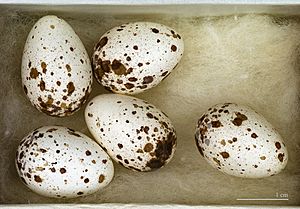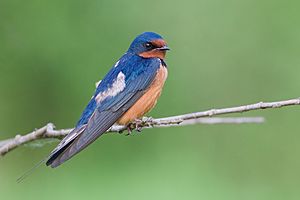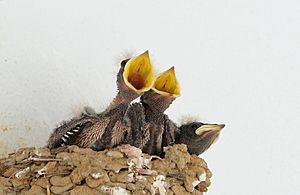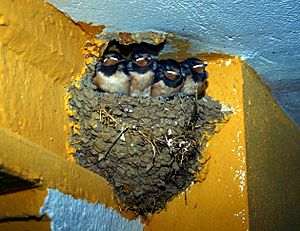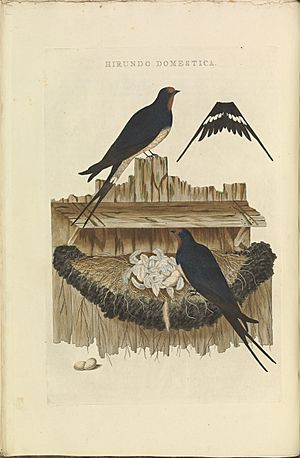Barn swallow facts for kids
Quick facts for kids Barn swallow |
|
|---|---|
 |
|
| European subspecies, H. r. rustica in Denmark |
|
| Scientific classification | |
| Kingdom: | |
| Class: | |
| Order: | |
| Family: | |
| Genus: |
Hirundo
|
| Binomial name | |
| Hirundo rustica Linnaeus, 1758
|
|
 |
|
The Barn swallow (Hirundo rustica) is the most common type of swallow found around the world. This special bird has shiny blue feathers on its back, a long, deeply forked tail, and pointed wings. You can find it in Europe, Asia, Africa, and the Americas. The barn swallow is even the national bird of Estonia.
There are six main types, or subspecies, of barn swallows. They breed across the Northern Hemisphere. Four of these types travel very long distances, flying south for winter. Their winter homes stretch across much of the Southern Hemisphere, reaching places like central Argentina, South Africa, and northern Australia. Because they live in so many places, barn swallows are not in danger of disappearing. However, their numbers might drop in some areas due to specific problems.
Barn swallows love open spaces with low plants, like farms and fields. They often build their nests on buildings made by people, like barns or under bridges. They make their cup-shaped nests from mud and eat insects they catch while flying. These birds live very close to humans. Since they eat insects, people usually don't mind them. In the past, people even had special beliefs about these birds and their nests, which helped protect them. You can find many stories and poems about the barn swallow because it lives near people and flies far away each year.
Contents
What Does a Barn Swallow Look Like?
An adult male barn swallow is about 17 to 19 centimeters (7 inches) long. This includes its long outer tail feathers, which can be 2 to 7 centimeters (up to 3 inches) long. Its wings stretch about 32 to 34.5 centimeters (13 inches) wide, and it weighs about 16 to 22 grams (less than an ounce).
It has shiny steel-blue feathers on its back. Its forehead, chin, and throat are a reddish-brown color. A wide, dark blue band crosses its chest, separating the reddish-brown from its off-white belly. The long outer tail feathers create the famous deeply forked "swallow tail." There are also white spots on the outer part of its upper tail.
The female barn swallow looks a lot like the male. However, her tail feathers are shorter, and the blue on her back and chest is not as shiny. Her belly is also a bit paler. Young barn swallows are browner. Their faces are a lighter reddish-brown, and their bellies are whiter. They also don't have the long tail feathers that adult birds do.
Barn Swallow Sounds
The barn swallow's song is a happy, chirping sound. It often ends with a "su-seer" sound, where the second note is higher. They also make "witt" or "witt-witt" calls. When they are excited or chasing away intruders from their nest, they make a loud "splee-plink" sound. They have different alarm calls for different dangers. For predators like cats, they make a sharp "siflitt." For birds of prey like the hobby, they make a "flitt-flitt" sound. These birds are usually quiet when they are in their winter homes.
Different Types of Barn Swallows
Scientists generally agree there are six main types, or subspecies, of barn swallows. These different types live and breed in various parts of the world.
- The European Barn Swallow (H. r. rustica) lives in Europe and Asia, even up to the Arctic Circle. It flies south to Africa, Arabia, and India for the winter. Some barn swallows from Europe fly over 11,660 kilometers (7,245 miles) on their yearly trip!
- The Middle Eastern Barn Swallow (H. r. transitiva) breeds in the Middle East, from southern Turkey to Israel. Some of these birds stay there all year, while others fly to East Africa for winter. This type has orange-red underparts and a broken blue band on its chest.
- The Egyptian Barn Swallow (H. r. savignii) lives in Egypt. It looks similar to the Middle Eastern type with orange-red underparts, but its chest band is complete and the red color is deeper.
- The East Asian Barn Swallow (H. r. gutturalis) has whitish underparts and a broken chest band. It breeds in places like Japan and Korea. These birds spend their winters across tropical Asia, from India to New Guinea. More and more are now spending winter in Australia.
- The Siberian Barn Swallow (H. r. tytleri) has deep orange-red underparts and an incomplete chest band. Its tail is also longer. It breeds in central Siberia and winters in places like Thailand and Malaysia.
- The North American Barn Swallow (H. r. erythrogaster) has redder underparts and a narrower, sometimes incomplete, blue chest band. It breeds all over North America, from Alaska to southern Mexico. It flies to places like Costa Rica and South America for the winter.
Scientists have found that barn swallows from North America actually spread to the Baikal region of Siberia. This is interesting because most birds spread from Eurasia to North America, not the other way around!
How Barn Swallows Live
Where They Live and Travel
Barn swallows like open areas with short plants, such as pastures, meadows, and farms. They prefer places with water nearby. They avoid thick forests or very steep areas, and also very busy cities. It's important for them to have open buildings like barns, stables, or bridges where they can build their nests. They also need places to perch, like wires or roof edges.
They breed in the Northern Hemisphere, from sea level up to about 2,700 meters (8,858 feet) high. They are not found in deserts or the very cold northern parts of continents. In many places, they avoid towns. However, in Honshū, Japan, barn swallows are more common in cities, while another type of swallow lives in the countryside.
In winter, barn swallows can be found in many different habitats, avoiding only dense forests and deserts. They are most common in open areas with low plants, like savannas. In places like Venezuela and South Africa, they are especially drawn to burnt or harvested fields. If there aren't good places to roost, they might sleep on wires, which makes them more open to predators.
Individual birds often return to the same wintering spot each year. They gather in huge groups to sleep in reed beds. These groups can be enormous; one in Nigeria had an estimated 1.5 million birds! These large roosts are thought to protect them from predators. Barn swallows have even been seen breeding in warmer parts of their winter range, like the mountains of Thailand.
We know a lot about their long migrations. For example, a barn swallow ringed in England in 1912 was found in South Africa! This shows how far these birds can travel. They have even been seen in distant places like Hawaii, Bermuda, and even Antarctica.
What They Eat
Barn swallows are like other birds that catch insects in the air. They are not super fast flyers, usually flying around 11 meters (36 feet) per second. But they are very good at turning and twisting in the air to catch flying insects. You often see them flying low over open areas.
They usually hunt about 7 to 8 meters (23 to 26 feet) above shallow water or the ground. They often follow animals, people, or farm machines to catch insects that are stirred up. Sometimes, they will even pick insects off the surface of water, walls, or plants. In their breeding areas, large flies make up about 70% of their diet. Aphids are also an important food source. In winter, flying ants are a key part of their diet. When laying eggs, barn swallows hunt in pairs, but at other times, they often form large groups.
Barn swallows drink by skimming low over lakes or rivers and scooping up water with their open mouths. They bathe in a similar way, dipping into the water for a quick moment while flying.
After breeding, swallows gather in large groups to roost, sometimes thousands strong. They often choose reed beds, swirling together before swooping low over the reeds. These reed beds are important for them to get enough food before and during their migration. Even though barn swallows fly and feed during the day while migrating, the reed beds help them build up or replace their fat reserves.
How They Breed
Male barn swallows usually return to the breeding grounds before the females. They choose a nest site and then try to attract females by flying in circles and singing. Females are more attracted to males with longer tail feathers. Males with longer tails are often healthier and live longer, so females choose them to have strong offspring. Males in northern Europe have longer tails than those further south.
Males with long tails also have larger white spots on their tails. Since feather-eating lice prefer white feathers, large white spots without damage from parasites also show that a male is healthy and strong.
Both male and female barn swallows protect their nest, but the male is especially protective. Once a pair forms, they usually stay together for life to breed.
As their name suggests, barn swallows typically build their nests inside buildings that are easy to get into, like barns and stables. They also nest under bridges. The nest is shaped like a neat cup and is built on a beam or against a suitable wall. Both the male and female build the nest, though the female does most of the work. They use mud pellets collected in their beaks and line the nest with grasses, feathers, or other soft materials.
Barn swallows might nest in groups if there are enough good nesting spots. Within a group, each pair protects a small area around their nest. In North America, barn swallows often have a helpful relationship with ospreys. Barn swallows will build their nests below an osprey nest. This gives them protection from other birds of prey, which the fish-eating ospreys scare away. In return, the swallows' alarm calls warn the ospreys about predators.
Before humans built so many structures, barn swallows nested on cliff faces or in caves, but this is rare now. The female lays two to seven eggs, but usually four or five. The eggs are white with reddish spots, about 20 by 14 millimeters (0.8 by 0.5 inches) in size. They weigh about 1.9 grams (0.07 ounces). In Europe, the female does almost all the incubation, but in North America, the male might help up to 25% of the time. The eggs usually hatch in 14 to 19 days. The chicks are born helpless and stay in the nest for another 18 to 23 days before they can fly.
Once the young birds can fly, they stay with their parents and are fed by them for about a week. Sometimes, young birds from the first group of chicks will help feed the second group.
Barn swallows will attack intruders like cats or hawks that come too close to their nest. They often fly very close to the threat. Adult barn swallows don't have many predators, but some are caught by hawks, falcons, and owls. It's rare for other birds like cowbirds or cuckoos to lay their eggs in a barn swallow's nest.
Barn swallows usually have two groups of chicks each year. They often reuse the same nest for the second group and repair it to use again in future years. About 90% of eggs hatch, and 70-90% of the chicks survive to fly. Most barn swallows live less than four years, though the oldest recorded bird lived for more than 11 years.
Young barn swallows have bright red mouths when they open them, which encourages their parents to feed them. Studies have shown that the brighter the red, the healthier the chick.
Barn swallows have sometimes bred with other types of swallows, like the American cliff swallow and the cave swallow in North America. They have also bred with the house martin in Europe and Asia.
Barn Swallows and Humans
Barn swallows are attractive birds that eat flying insects, so people have generally welcomed them when they nest in their buildings. Since they are one of the first birds to return in spring, they are seen as an early sign that summer is coming.
In ancient times, barn swallows already used buildings and bridges made by humans. An old Roman poem from 29 BC mentions a "twittering swallow hangs its nest from the rafters."
Some farmers used to believe that swallows spread certain infections to cows. However, a study in Sweden found no proof that the birds carried such bacteria.
In Stories and Poems
Many stories and poems use the barn swallow's journey north as a symbol of spring or summer. There's a famous saying that goes back to ancient Greece: "One swallow does not make a summer." This means that one good thing doesn't mean everything is perfect.
The swallow also appears in famous poems, symbolizing spring, love, or even the end of summer. William Shakespeare mentioned swallows in his plays to show how fast they fly or to talk about their yearly migration.
In Culture
In the past, people were very tolerant of barn swallows because they ate insects. This was also helped by old beliefs that harming a barn swallow's nest could bring bad luck, like cows giving bloody milk or hens stopping their egg-laying. This might be why swallows' nests can last for a very long time. It's common for nests to be used for 10 to 15 years, and one nest was even used for 48 years!
Sailors often get a swallow tattoo as a symbol of a safe return home. The tradition was to get one swallow tattoo after sailing 5,000 nautical miles (about 9,260 kilometers or 5,754 miles). A second swallow would be added after 10,000 nautical miles at sea.
The barn swallow is shown in heraldry (family crests) as a "Martlet." It often represents younger sons who don't inherit land. It's sometimes shown without feet because people used to believe swallows didn't have feet. Since June 23, 1960, the barn swallow has been the national bird of Estonia.
Barn Swallow Status
The barn swallow lives across a huge area, estimated to be about 51.7 million square kilometers (20 million square miles). There are about 190 million individual birds. Because of its wide range and large population, the species is listed as "least concern" on the IUCN Red List. This means it is not currently in danger of extinction.
Historically, this bird has actually benefited from humans clearing forests, which created the open habitats it likes. It also benefited from human buildings, which gave it many safe places to nest. However, there have been some local drops in numbers. For example, the use of DDT in Israel in the 1950s caused problems. In the 1800s, house sparrows competed for nest sites in the US. Today, farming changes in parts of Europe and Asia are reducing the number of insects available for food, causing a gradual decline. On the other hand, the population in North America grew in the 20th century because more nesting sites became available.
Climate change might also affect barn swallows. Dry weather can make them lose weight and slow down feather growth. The growing Sahara desert will make it harder for European birds to migrate. Hot, dry summers could mean fewer insects for chicks to eat. However, warmer springs might also mean a longer breeding season and more chicks.
Images for kids
See also
 In Spanish: Golondrina común para niños
In Spanish: Golondrina común para niños


